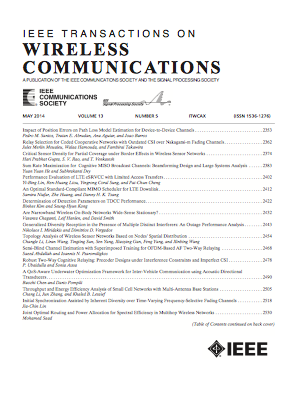Joint Activity Detection and Channel Estimation in MIMO Grant-Free Random Access Networks
IF 10.7
1区 计算机科学
Q1 ENGINEERING, ELECTRICAL & ELECTRONIC
引用次数: 0
Abstract
Massive machine communication is predicted to provide widespread and unparalleled connectivity for cellular Internet of Things (IoT) applications via multiple-input multiple-output (MIMO) and grant-free random access (GF-RA) techniques. Compressed sensing (CS) has been widely advocated to support massive connectivity due to the bursty nature of traffic transmission. In this paper, the joint activity detection and channel estimation in MIMO-enabled GF-RA system is formulated as a block single measurement vector (SMV) problem and efficiently addressed by using Bayesian-based CS algorithms. First, the pattern coupled sparse Bayesian learning (PCSBL) and block sparse Bayesian learning (BSBL) algorithms are introduced to solve this problem, where the potential block sparsity properties induced by multi-antenna reception are exploited by assigning the structured hyperpriors. Then, by embedding the Generalized Approximate Message Passing (GAMP) technique into the PCSBL and BSBL frameworks to enable effective approximation of posterior distributions, we propose two computationally efficient Bayesian learning algorithms, i.e., GAMP-PCSBL and GAMP-BSBL. Fortunately, the proposed Bayesian algorithms allow automatic learning of block sparse solutions without requiring noise level and user sparsity ratio as explicit conditions. Simulation results show that the proposed algorithms provide improved performance gains over the standard CS-based methods.MIMO无授权随机接入网络中的联合活动检测与信道估计
预计大规模机器通信将通过多输入多输出(MIMO)和无授权随机访问(GF-RA)技术,为蜂窝物联网(IoT)应用提供广泛和无与伦比的连接。由于流量传输的突发性,压缩感知(CS)被广泛提倡支持大规模连接。本文将基于mimo的GF-RA系统中的联合活动检测和信道估计问题表述为一个块单测量向量(SMV)问题,并采用基于贝叶斯的CS算法有效地解决了该问题。首先,引入模式耦合稀疏贝叶斯学习(PCSBL)和块稀疏贝叶斯学习(BSBL)算法来解决这一问题,其中通过分配结构化超先验来利用多天线接收引起的潜在块稀疏性。然后,通过将广义近似消息传递(GAMP)技术嵌入到PCSBL和BSBL框架中,以实现对后验分布的有效逼近,我们提出了两种计算效率高的贝叶斯学习算法,即GAMP-PCSBL和GAMP-BSBL。幸运的是,所提出的贝叶斯算法允许块稀疏解的自动学习,而不需要噪声水平和用户稀疏比作为显式条件。仿真结果表明,所提出的算法比标准的基于cs的方法提供了更高的性能增益。
本文章由计算机程序翻译,如有差异,请以英文原文为准。
求助全文
约1分钟内获得全文
求助全文
来源期刊
CiteScore
18.60
自引率
10.60%
发文量
708
审稿时长
5.6 months
期刊介绍:
The IEEE Transactions on Wireless Communications is a prestigious publication that showcases cutting-edge advancements in wireless communications. It welcomes both theoretical and practical contributions in various areas. The scope of the Transactions encompasses a wide range of topics, including modulation and coding, detection and estimation, propagation and channel characterization, and diversity techniques. The journal also emphasizes the physical and link layer communication aspects of network architectures and protocols.
The journal is open to papers on specific topics or non-traditional topics related to specific application areas. This includes simulation tools and methodologies, orthogonal frequency division multiplexing, MIMO systems, and wireless over optical technologies.
Overall, the IEEE Transactions on Wireless Communications serves as a platform for high-quality manuscripts that push the boundaries of wireless communications and contribute to advancements in the field.

 求助内容:
求助内容: 应助结果提醒方式:
应助结果提醒方式:


